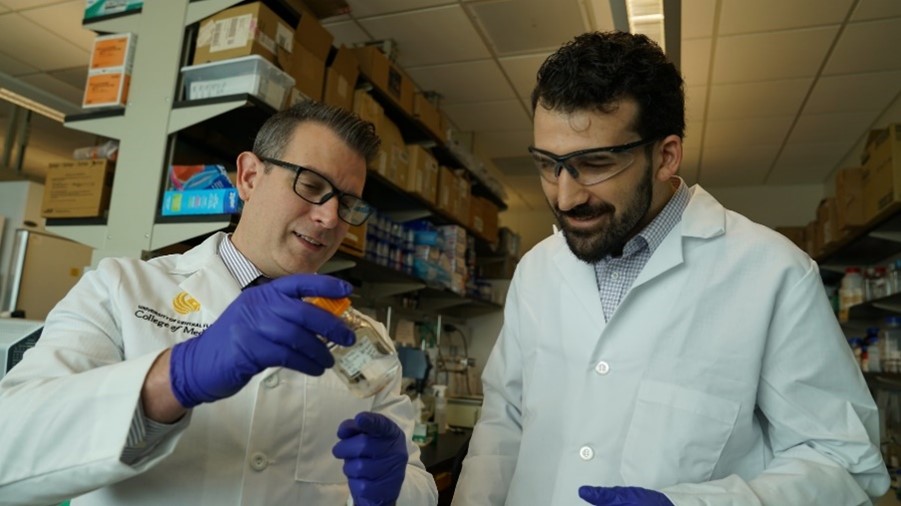A UCF research team has engineered tissue with human cells that mosquitoes love to bite and feed upon—with the goal of helping fight deadly diseases transmitted by the biting insects.
A multidisciplinary team led by College of Medicine biomedical researcher Dr. Bradley Jay Willenberg with Drs. Mollie Jewett (UCF Burnett School of Biomedical Sciences) and Andrew Dickerson (University of Tennessee) lined 3D capillary gel biomaterials with human cells to create engineered tissue and then infused it with blood. Testing showed mosquitoes readily bite and blood feed on the constructs. Scientists hope to use this new platform to study how pathogens that mosquitoes carry impact and infect human cells and tissues. Presently, researchers rely largely upon animal models and cells cultured on flat dishes for such investigations.
Further, the new system holds great promise for blood feeding mosquito species that have proven difficult to rear and maintain as colonies in the laboratory, an important practical application. The Willenberg team’s work was published Friday in the journal Insects.
Mosquitos have often been called the world’s deadliest animal, as vector-borne illnesses, including those from mosquitos cause more than 700,000 deaths worldwide each year. Malaria, dengue, Zika virus and West Nile virus are all transmitted by mosquitos. Even for those who survive these illnesses, many are left suffering from organ failure, seizures and serious neurological impacts.
“Many people get sick with mosquito-borne illnesses every year, including in the United States. The toll of such diseases can be especially devastating for many countries around the world,” Dr. Willenberg said.
This worldwide impact of mosquito-borne disease is what drives Dr. Willenberg, whose lab employs a unique blend of biomedical engineering, biomaterials, tissue engineering, nanotechnology and vector biology to develop innovative mosquito surveillance, control and research tools. He said he hopes to adapt his new platform for application to other vectors such as ticks, which spread Lyme disease. “We have demonstrated the initial proof-of-concept with this prototype” he said. “I think there are many potential ways to use this technology.”

Captured on video, Dr. Willenberg observed mosquitoes enthusiastically blood feeding from the engineered tissue, much as they would from a human host. This demonstration represents the achievement of a critical milestone for the technology: ensuring the tissue constructs were appetizing to the mosquitoes.
“As one of my mentors shared with me long ago, the goal of physicians and biomedical researchers is to help reduce human suffering,” he explained. “So, if we can provide something that helps us learn about mosquitoes, intervene with diseases and, in some way, keep mosquitoes away from people, I think that is a positive.”
Dr. Willenberg came up with the engineered tissue idea when he learned the National Institute of Health (NIH) was looking for new in vitro 3D models that could help study pathogens that mosquitoes and other biting arthropods carry.
“When I read about the NIH seeking these models, it got me thinking that maybe there is a way to get the mosquitoes to bite and blood feed [on the 3D models] directly,” he said. “Then I can bring in the mosquito to do the natural delivery and create a complete vector-host-pathogen interface model to study it all together.”
As this platform is still in its early stages, Dr. Willenberg wants to incorporate addition types of cells to move the system closer to human skin. He is also developing collaborations with experts that study pathogens and work with infected vectors, and is working with mosquito control organizations to see how they can use the technology.
“I have a particular vision for this platform, and am going after it. My experience too is that other good ideas and research directions will flourish when it gets into the hands of others,” he said. “At the end of the day, the collective ideas and efforts of the various research communities propel a system like ours to its full potential. So, if we can provide them tools to enable their work, while also moving ours forward at the same time, that is really exciting.”
Dr. Willenberg received his Ph.D. in biomedical engineering from the University of Florida and continued there for his postdoctoral training and then in scientist, adjunct scientist and lecturer positions. He joined the UCF College of Medicine in 2014, where he is currently an Assistant Professor of Medicine.
Dr. Willenberg is also a co-founder, co-owner and manager of Saisijin Biotech, LLC and has a minor ownership stake in Sustained Release Technologies, Inc. Neither entity was involved in any way with the work presented in this story. Team members may also be listed as inventors on patent/patent applications that could result in royalty payments. This technology is available for licensing. To learn more, please visit https://ucf.flintbox.com/technologies/44c06966-2748-4c14-87d7-fc40cbb4f2c6.